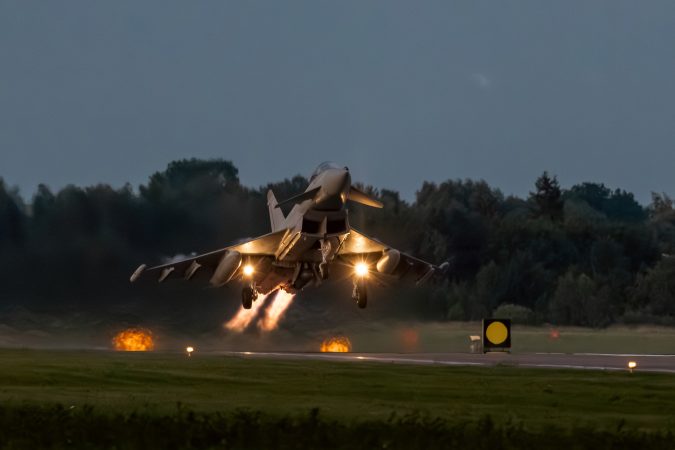NATO scrambled a French Rafale Sept. 13 in resonse to a potential Russian drone incursion into Poland—the first time it has done so since implementing a new plan to bolster defenses against Russian air incursions last week, the officials from the alliance’s military command said.
The French jet was launched as part of Operation Eastern Sentry, as the new mission is called, but the drone did not ultimately violate Polish airspace and no further action was necessary.
“The response was fast, and the alert was over quickly,” said NATO Supreme Allied Commander and U.S. European Command boss U.S. Air Force Gen. Alexus G. Grynkewich in a Sept. 15 statement. “The limited use of assets was correct and calibrated to the potential threat perceived, which speaks to the utility of Eastern Sentry.”
Eastern Sentry is modeled on Baltic Sentry, an operation launched in the Baltic Sea early this year to defend critical infrastructure from potential Russian attacks.
France has contributed three jets to Eastern Sentry, and more nations are expected to deploy fighter jets for the mission mission, Western officials told Air & Space Forces Magazine. Britain’s Royal Air Force will contribute Eurofighter Typhoons to missions over Poland “in the coming days,” the U.K. Ministry of Defense announced Sept. 15.
Last week, 19 Russian drones flew into Polish airspace and days later another Russian drone breached Romanian airspace. Several of the drones over Poland were downed by Dutch F-35 Lightning II fighters, which had deployed there at the beginning of September. The rest of the drones crashed. Polish F-16s and other allied and NATO support aircraft assisted in the engagements.
The RAF Typhoons will “bolster NATO’s defence and deterrence along its eastern flank,” the U.K. MOD said in a news release. The RAF jets will operate from England, however, flying from RAF Coningsby and supported by Voyager aerial refuelling aircraft from RAF Brize Norton.
“These aircraft are not just a show of strength, they are vital in deterring aggression, securing NATO airspace, and protecting our national security and that of our allies,” U.K. Prime Minister Keir Starmer said in a statement.

In addition to the three French Rafales, four German Eurofighters are stationed at a base in northeastern Poland. Denmark is also contributing multiple F-16s to the mission, and the Czech Republic is contributing three helicopters, which arrived in Poland Sept. 14. An air defense warship will also be part of the operation.
Spain is expected to announce its military support to the operation soon, and Italy and Sweden have “signaled they will aid” Eastern Sentry, Supreme Headquarters Allied Powers Europe (SHAPE), NATO’s military arm, announced Sept. 15. It is unclear how many more of NATO’s 32 members will sign on to the pact.
“I commend allies for providing these additional capabilities,” Grynkewich said in a statement.
The U.S. military has not disclosed any participation in Eastern Sentry. The Pentagon did not immediately respond to a request for comment when asked whether the U.S. plans to contribute aircraft or any other military assets to the mission.
The U.S. previously stationed fighters on NATO’s eastern flank before the current mission, including F-15E Strike Eagles from the 336th Fighter Squadron stationed at Seymour-Johnson Air Force Base, N.C., which was deployed to Poland to help reinforce the eastern flank in the days leading up to the February 2022 Russian invasion of Ukraine.
“That’s exactly what we would have been there for—to go after [the Russian drones],” Air Force Col. Brent Peterson, who commanded the squadron at the time of Russia’s invasion, said Sept. 14 during a Heritage talk hosted by the Air & Space Forces Association during the Joint Base Andrews, Md., Air Show. “To the credit of some of our NATO brethren, they were able to intercept some of them and shoot them down.”
NATO has offered limited details on the ultimate full scope and timeline of the operation, which Grynkewich said Sept. 12 was still to be determined.
“I envision it is going to cover the entire eastern flank of the alliance, from the High North to the Black Sea and the Mediterranean,” he said. “Anywhere that we might see a threat from the Russians.”
Matthew Cox contributed reporting.


